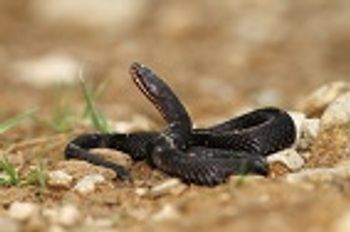
Humans probably had a hand in spreading dog-related rabies virus worldwide, according to a report in PLOS Pathogens, and the virus may require only minimal adaptive evolution to jump to new host species.
Dr. Walden received her doctorate in veterinary medicine from North Carolina State University. She is a practicing veterinarian and a certified editor in the life sciences (ELS). She owns Walden Medical Writing, LLC, and writes and edits materials for healthcare professionals and the general public.

Humans probably had a hand in spreading dog-related rabies virus worldwide, according to a report in PLOS Pathogens, and the virus may require only minimal adaptive evolution to jump to new host species.

A report published in PLOS One describes the prevalence of four vector-borne diseases in gray wolves in Wisconsin.

In a recent study, dogs with pituitary-dependent hyperadrenocorticism treated with trilostane had significantly longer survival times than those that received no treatment.

A recent study finds that natural therapies may be derived from mammalian microbiota obtained from roadkill.

New research shows that stem cell–derived transplants may help restore vision in end-stage retinal degeneration.

Researchers found recently that cranberry extract does not reduce the incidence of bacteriuria in dogs with acute intervertebral disk herniation.

As in dogs, body weight has a clinically relevant effect on echocardiographic measurements in cats.

In a first-of-its-kind international study, researchers have found that dog walking increased levels of perceived neighborhood surveillance and safety in some communities.

Most people want to know only one thing about fleas: how to kill them. Flea control is much easier than it once was, though preventing fleas is still simpler than treating an established infestation.

More than 12,000 Americans are diagnosed annually with cat-scratch disease. The CDC retrospectively analyzed national health insurance claims over an 9-year period to ascertain the incidence, clinical significance, and cost of this largely preventable zoonosis.

A new study from BMC Research sheds light on resistance levels in bacteria from the urinary tract in dogs and cats in Europe.

In Aesop’s fable “The Crow and the Pitcher,” a thirsty crow drops stones into a pitcher to raise the water level high enough to reach. But will real birds do the same, and can they understand why it happens?

Dr. Tom Meyer, president of AVMA, clears Santa’s reindeer for travel and reminds the public that veterinary health certificates are needed for animals to travel across state lines or to other countries.

A study recently published in Current Biology, finds that dogs may have episodic memory.

A pilot study finds that equine-assisted therapy may have the potential to improve symptoms of ADHD in children due to the fact that it produces connectivity changes in certain areas of the brain.

Researchers find that there are several characteristics that dogs have that make them good models for human rare diseases.

Study finds that a nutraceutical diet combined with topical drug treatment improved clinical signs in dogs with keratoconjunctivitis sicca (KCS).

A recent report discusses the clinical signs and treatment response pertaining to exocrine pancreatic insufficiency in cats.

A recent clinical trials shows that pimobendan delays the onset of congestive heart failure in dogs with mitral valve disease and cardiomegaly by a median of 15 months.

University of Guelph researchers explain their methods of estimating the number of free-roaming cats that inhabit Guelph in recent study.

Oregon State University researchers have discovered a second pathogen in vector of salmon poisoning disease that allows for dogs to become infected a second time.

Researchers suggest that bees use multiple sensory cues, previous experience, and possibly feedback from other bees in their search for pollen.

A recent study has found that mammals who live in zoos have a longer life expectancy that those living in the wild.

A review article discusses the neurobiological factors that affect dogs’social-cognitive responses to humans.

In a longitudinal study of young miniature schnauzers and Labrador retrievers, age and breed had statistically significant effects on hematological and biochemical parameters during the first year of life.

A survey of 127 participants examined veterinary use of fluoxetine in treating feline and canine behavioral disorders.

According to a study published in Virology, researchers are on the path to creating a new vaccine that can be used in the battle against canine influenza.

New research may have uncovered how snakes have evolved to be limbless.

Researchers from Queen Mary University in London, England, have found evidence that indicates an emotion-like states in bees.

In an article recently published in Morbidity and Mortality Weekly Report, the Centers for Disease Control and Prevention (CDC) reported seven cases of human baylisascariasis, the cases occurring in six states from May 2013 through December 2015.